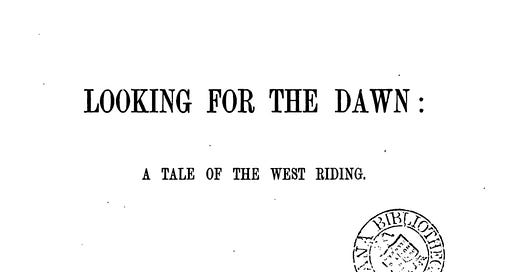Looking For The Dawn by James Burnley
Love among the political upheaval of industrial Yorkshire in the 1840s
I can’t remember now where I learnt of the existence of this 1874 novel subtitled ‘A Tale of the West Riding’ but I noted down on my To Read list at the time that its author was a journalist who had covered the Chartist uprisings of the 1840s and then written the novel 30 years later. Now that I come to look into the background of James Burnley to write this article, I find that he was only a small child at the time of the unrest, but he is from the West Riding — Shipley1 to be precise — and worked in a textile mill in his youth. Consequently, while he doesn’t seem to have reported on Chartists2, he may have been surrounded by them as a lad, and would certainly have had access to those in the area with long memories.
In any case, despite Chartism being the reason3 I downloaded this novel (scanned in from some library or other) it isn’t the central feature of the plot. That could be said to be Love Conquers All, or some such thing. In other words it is at its core a love story. It’s not in the league of Anthony Trollope or Jane Austen on that front, descending into melodrama and sentimentality at times. In fact the whole book was laden with purple prose and as subtle as a brick.
The town, which is built on the woollen industry, is called Woolborough, and the only Scottish character is one ‘Sandy McTartan’. The wrong’un is telegraphed as such with every word, deed and costume choice. We have (naturally) the poor factory girl with a pure and noble heart; the angry Squire who is a pompous snob; the dissipated wastrel who has been corrupted by University life and the decadent rich lads he encountered there.4 However, it was readable enough if you’re used to nineteenth century novels and I did get all the way to the end of its approximately 400 pages.
Set in 1848, year of revolution across the continent, the textile workers of the town of Woolborough are not happy with their lot. The Chartists are still promising a brighter tomorrow, and organising mass meetings that are all talk and no action. Still, it’s an evening out and many people from the town turn up whether they’re interested in Chartism or not. For someone with connections, it’s a great opportunity to get rivals and nuisances arrested as activists, a serious charge; the squire will happily convict anyone as he believes all workers are infected with this political poison and they’re all stirring up revolution. It’s up to someone else with connections to try to get the innocent parties proved innocent.
Chartism in brief
For those of you who don’t know much about Chartism, the basic idea was that they (British workers, led by Feargus O’Connor) had a charter for electoral reform: annual ballots; secret ballots; universal suffrage (for men); a salary for MPs, and something else I’ve forgotten. Everything except the annual ballots was eventually enacted but in the 1830s-40s it was considered radical madness. They were fond of marches and mass meetings on moors and waste ground, and there was inevitably some violence, including an infamous incident in Wales that Michael Sheen made a TV programme about.
The review5 of the new novel in The Leeds Mercury of 16th December 1874 calls it ‘a real Yorkshire story, not destitute of merit’. The Wharfedale and Airedale Observer appears to have serialised it in 1886, and The Brighouse News in 1898, so it was presumably popular with the local reading public. Burnley himself already had a reputation as a poet and writer of — I think — local history.
I mainly read Looking For The Dawn out of historical interest and although I did kind of enjoy it, I’m not sure anyone would read it now simply because they were looking for a good story6. Tastes and conventions change, very few popular novelists are still being read even a few decades after publication, never mind a century and a half. No disrespect at all intended to Richard Osman who’s clearly doing something that pleases millions of readers, but I doubt he’ll be read much in 150 years either. Still, it was nice to read a novel that was a little off the beaten track.
One interesting aside: the working folk are rendered in dialect and I find his spelling a bit harder to get the hang of than JB Priestley’s in The Good Companions. I couldn’t decide whether Burnley wasn’t as good at it or whether pronunciation had changed in the meantime. There’s the odd word I don’t understand too, but it was written 55 years before The Good Companions. I learnt dialect predominantly from my Nana and her peers (friends, cousins), who were children when The Good Companions came out; the 1870s is when their grandparents were small — a lot can change in that time. It has made me want to revisit the book of dialect poems I inherited from my great-uncle though (Benjamin Preston’s 1872 collection). No doubt if I do, I’ll write about them here.
In Airedale, near Bingley, for Lee-Ann’s Spare Fridays fans who were wondering
He was a journalist later in life, however
I have mentioned before my oft-stated intention to write a novel set among the Chartists of the West Riding. How could I resist one that’s already been written?
Is that really any worse than Dickens? Admittedly I’ve only read about 3 of his novels and I’m not a fan.
It is effectively a synopsis of the entire plot with a couple of contextual sentences! No point in reading the book if you’ve read it.
It seems like it’s going in one direction then strikes off in another. A scene I assumed would be of grave importance is never referred to again.




